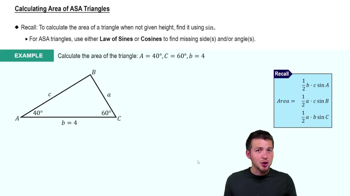Find the angle between each pair of vectors. Round to two decimal places as necessary.
2i + 2j, -5i - 5j
 Verified step by step guidance
Verified step by step guidance



Find the angle between each pair of vectors. Round to two decimal places as necessary.
2i + 2j, -5i - 5j
Let u = 〈-2, 1〉, v = 〈3, 4〉, and w = 〈-5, 12〉. Evaluate each expression.
(3u) • v
Let u = 〈-2, 1〉, v = 〈3, 4〉, and w = 〈-5, 12〉. Evaluate each expression.
u • v - u • w
CONCEPT PREVIEW Refer to vectors a through h below. Make a copy or a sketch of each vector, and then draw a sketch to represent each of the following. For example, find a + e by placing a and e so that their initial points coincide. Then use the parallelogram rule to find the resultant, as shown in the figure on the right.
<IMAGE>
2c
Determine the number of triangles ABC possible with the given parts.
a = 31, b = 26, B = 48°
Determine whether each pair of vectors is orthogonal.
〈1, 1〉, 〈1, -1〉